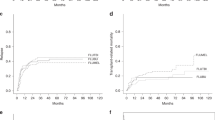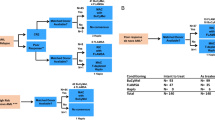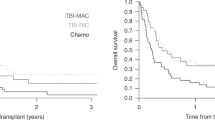Summary:
We analyzed predictive factors for the outcome of 113 acute myeloid leukemia patients receiving reduced-intensity conditioning prior to allogeneic hematopoietic stem cell transplantation (HSCT). Patients were ineligible for conventional-intensity HSCT. Conditioning consisted of fludarabine and 50% of the conventional dose of busulfan (n=93) or total body irradiation (n=20). The source of stem cells was blood in 102 patients, marrow in 10, and both in one. In total, 50 (44.2%) donors were HLA-matched siblings, 50 (44.2%) unrelated fully matched and 13 (11.5%) partially mismatched family (n=1) or unrelated (n=12) donors. In all, 107 (94.6%) patients showed neutrophil and platelet engraftment after a median time of 13.5 and 13 days. The probabilities of event-free survival (EFS) (median follow-up: 12 months) were 49% for patients with less than 5% blasts in the marrow, 24% for patients with 5–20% blasts (P=0.002) and 14% with >20% blasts (P⩽0.001). Death occurred because of relapse in 29 patients (25.6%), infection in 12 patients (10.6%), acute graft-versus-host disease in eight patients (7.0%) and organ toxicity in nine patients (7.9%). In multivariate analysis, higher number of blasts in the marrow, alternative donors and low Karnofsky performance score were independent adverse prognostic factors for EFS.
This is a preview of subscription content, access via your institution
Access options
Subscribe to this journal
Receive 12 print issues and online access
$259.00 per year
only $21.58 per issue
Buy this article
- Purchase on Springer Link
- Instant access to full article PDF
Prices may be subject to local taxes which are calculated during checkout





Similar content being viewed by others
References
Wiernik PH, Banks PLC, Case Jr DC et al. Cytarabine plus idarubicin or daunorubicin as induction and consolidation therapy for previously untreated adult patients with acute myeloid leukemia. Blood 1992; 79: 313–319.
Bishop JF, Matthews JP, Young GA et al. A randomized study of high-dose cytarabine in induction in acute myeloid leukemia. Blood 1996; 87: 1710–1717.
Cassileth PA, Harrington DP, Appelbaum FR et al. Chemotherapy compared with autologous or allogeneic bone marrow transplantation in the management of acute myeloid leukemia in first remission. N Engl J Med 1998; 339: 1649–1656.
Frassoni F, Labopin M, Gluckman E et al. Results of allogeneic bone marrow transplantation for acute leukaemia have improved over time in Europe. Bone Marrow Transplant 1996; 17: 13–18.
Cift R, Buckner C, Appelbaum F et al. Allogeneic marrow transplantation in patients with acute myeloid leukemia in first remission: a randomized trial of two irradiation regimens. Blood 1990; 76: 1867–1871.
Auer I, Gale R . Are new conditioning regimens for transplantation in acute myelogenous leukemia better? Bone Marrow Transplant 1991; 4: 255–262.
Yin JA, Johnson PRE . Clinical annotation. Acute myeloid leukaemia in the elderly: biology and treatment. Br J Haematol 1993; 83: 1–6.
Weiden P, Flournoy N, Thomas E et al. Antileukemic effect of graft-versus-host disease in human recipients of allogeneic-marrow grafts. N Engl J Med 1979; 300: 1068–1073.
Kolb HJ, Schattenberg A, Goldman J et al. Graft-versus-leukemia effect of donor lymphocyte transfusions in marrow grafted patients. European Group for Blood and Marrow Transplantation Working Party Chronic Leukemia. Blood 1995; 86: 2041–2050.
McSweeney PA, Niederwieser D, Shizuru JA et al. Hematopoietic cell transplantation in older patients with hematologic malignancies: replacing high-dose cytotoxic therapy with graft-versus-tumor effects. Blood 2001; 97: 3390–3400.
Giralt S, Estey E, Albitar M et al. Engraftment of allogeneic hematopoietic progenitor cells with purine analog-containing chemotherapy: harnessing graft-versus-leukemia without myeloablative therapy. Blood 1997; 89: 4531–4536.
Corradini P, Tarella C, Olivieri A et al. Reduced-intensity conditioning followed by allografting of hematopoietic cells can produce clinical and molecular remissions in patients with poor-risk hematologic malignancies. Blood 2002; 99: 75–82.
Giralt S, Thall PF, Khouri I et al. Melphalan and purine analog-containing preparative regimens: reduced-intensity conditioning for patients with hematologic malignancies undergoing allogeneic progenitor cell transplantation. Blood 2001; 97: 631–637.
Slavin S, Nagler A, Naparstek Y et al. Nonmyeloablative stem cell transplantation and cell therapy as an alternative to conventional bone marrow transplantation with lethal cytoreduction for the treatment of malignant and nonmalignant hematologic diseases. Blood 1998; 91: 756–763.
Kottaridis DP, Milligan DW, Chopra R et al. In vivo CAMPATH-1H prevents graft-versus-host disease following nonmyeloablative stem cell transplantation. Blood 2000; 96: 2419–2425.
Ottinger HD, Albert E, Arnold R et al. German consensus on immunogenetic donor search for transplantation of allogeneic bone marrow and peripheral blood stem cell. Bone Marrow Transplant 1997; 20: 101–105.
Kaplan E, Meier P . Nonparametric estimation from incomplete observations. J Am Stat Assoc 1958; 53: 457–462.
Venditti A, Buccisano F, Del Poeta G et al. Level of minimal residual disease after consolidation therapy predicts outcome in acute myeloid leukaemia. Blood 2000; 96: 3948–3952.
Sierra J, Storer B, Hansen JA et al. Unrelated donor marrow transplantation for acute myeloid leukemia: an update of the Seattle experience. Bone Marrow Transplant 2000; 26: 397–404.
Tallman MS, Rowlings PA, Milone G et al. Effect of postremission chemotherapy before human leukocyte antigen- identical sibling transplantation for acute myelogenous leukemia in first complete remission. Blood 2000; 96: 1254–1258.
Bensinger WI, Martin PJ, Storer B et al. Transplantation of bone marrow as compared with peripheral-blood cells from HLA-identical relatives in patients with hematologic cancers. N Engl J Med 2001; 344: 175–181.
Panse JP, Heimfeld S, Guthrie KA et al. Effect of PBSC graft-composition on T-cell chimerism, rejection and outcome in non-myealoablative HSCT: NK-cells predict for T-cell engraftment. Blood 2001; 98: 477a [Abstr.].
Bornhäuser M, Thiede C, Platzbecker U et al. Dose-reduced conditioning and allogeneic hematopoietic stem cell transplantation from unrelated donors in 42 patients. Clin Cancer Res. 2001; 7: 2254–2262.
Socié G, Stone JV, Wingard JR et al. Long-term survival and late deaths after allogeneic bone marrow transplantation. N Engl J Med 1999; 341: 14–21.
Maury S, Mary JY, Rabian C et al. Prolonged immune deficiency following allogeneic stem cell transplantation: risk factors and complications in adult patients. Br J Haematol 2001; 115: 630–641.
Michallet M, Bilger K, Garban F et al. Allogeneic hematopoietic stem-cell transplantation after nonmyeloablative preparative regimens: impact of pretransplantation and posttransplantation factors on outcome. J Clin Oncol 2001; 19: 3340–3349.
Martino R, Caballero MD, Peres Simon JA et al. Evidence for a graft-versus-leukemia effect after allogeneic peripheral blood stem cell transplantation with reduced-intensity conditioning in acute myelogenous leukemia and myelodysplastic syndromes. Blood 2002; 100: 2243–2245.
Acknowledgements
We thank all of the physicians and nursing staff in the participating study centers that have been involved in the care of the patients. This work was supported in part by the Kompetenznetz ‘Akute und Chronische Leukämien’. Parts of the study were presented at the 43rd Annual Meeting of the American Society of Hematology in Orlando Florida, December 2001.
Author information
Authors and Affiliations
Consortia
Rights and permissions
About this article
Cite this article
Sayer, H., Kröger, M., Beyer, J. et al. Reduced intensity conditioning for allogeneic hematopoietic stem cell transplantation in patients with acute myeloid leukemia: disease status by marrow blasts is the strongest prognostic factor. Bone Marrow Transplant 31, 1089–1095 (2003). https://doi.org/10.1038/sj.bmt.1704062
Received:
Accepted:
Published:
Issue Date:
DOI: https://doi.org/10.1038/sj.bmt.1704062
Keywords
This article is cited by
-
Fecal microbiota transplantation in capsules for the treatment of steroid refractory and steroid dependent acute graft vs. host disease: a pilot study
Bone Marrow Transplantation (2024)
-
Long-term outcomes in patients with relapsed/refractory acute myeloid leukemia and other high-risk myeloid malignancies after undergoing sequential conditioning regimen based on IDA-FLAG and high-dose melphalan
Bone Marrow Transplantation (2022)
-
Unmanipulated haploidentical versus HLA-matched sibling allogeneic hematopoietic stem cell transplantation in relapsed/refractory acute myeloid leukemia: a retrospective study on behalf of the ALWP of the EBMT
Bone Marrow Transplantation (2019)
-
Allogeneic hematopoietic cell transplantation for patients with a history of multiple relapses of acute myeloid leukemia
Annals of Hematology (2019)
-
Unrelated donor versus matched sibling donor in adults with acute myeloid leukemia in first relapse: an ALWP-EBMT study
Journal of Hematology & Oncology (2016)



